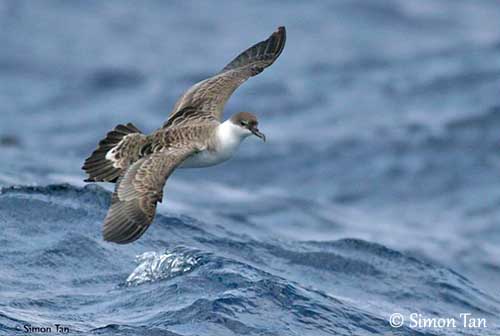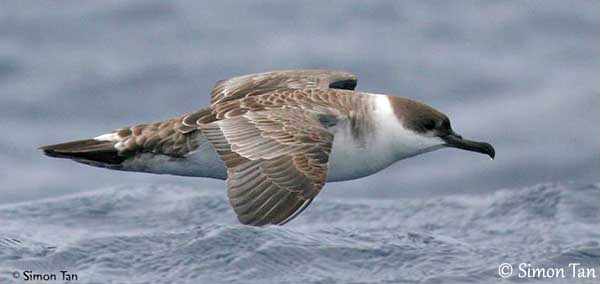
Fr: Puffin majeur
Ang: Great Shearwater
All: Großer Sturmtaucher
Esp: Pardela Capirotada
Ita: Berta dell'Atlantico
Nd: Grote Pijlstormvogel
Sd: Större lira
Photographers:
Simon Tan
PBase Bird galleries
Alan & Ann Tate
AA Bird Photography
Text by Nicole Bouglouan
Sources:
HANDBOOK OF THE BIRDS OF THE WORLD vol 1 by Josep del Hoyo-Andrew Elliot-Jordi Sargatal - Lynx Edicions - ISBN: 8487334105
A Complete Guide to Antarctic Wildlife by Hadoram Shirihai and Illustrated by Brett Jarrett - Edited by Guy M. Kirwan - ALUL.A Press Oy, Finland - ISBN 9519894705
THE HANDBOOK OF BIRD IDENTIFICATION FOR EUROPE AND THE WESTERN PALEARCTIC by Mark Beaman, Steve Madge - C. Helm - ISBN: 0713639601
BirdLife International (BirdLife International)
Animal Diversity Web (University of Michigan Museum of Zoology)
What Bird-The ultimate Bird Guide (Mitchell Waite)
Wikipedia, the free encyclopaedia
Great Shearwater
Ardenna gravis
Procellariiformes Order – Procellariidae Family
INTRODUCTION:
The Great Shearwater is a gregarious species, breeding colonially and forming large foraging flocks at sea. This is a typical shearwater that breeds in burrows and feeds on squid, fish and crustaceans caught by pursuit-plunging. They may attend the trawlers in large numbers too.
This species breeds in Falkland Islands and Tristan da Cunha group.

DESCRIPTION OF THE BIRD:
Biometrics:
Length: 47 cm
Wingspan: 100-118 cm
Weight: 830 g
The adult has greyish-brown upperparts with pale-edged feathers involving scaled effect. The uppertail-coverts are white and form a white crescent at base of the tail. The rectrices are darker brown.
The underparts are white, but there is a variable, weak, brownish patch on belly, sometimes mottled. On the underwing, the flight-feathers have dark greyish tips forming a conspicuous trailing edge, usually broader at wing tip. The bases of the flight feathers and most of coverts are white. A variable dark pattern is visible on axillaries and at leading edge, formed by dark stripes and spots on lesser and median underwing-coverts.
On the head, the crown to gape-level and back to the nape is sooty-brown, contrasting strongly with a conspicuous white collar (it can be incomplete at hindneck). The bird can show a partial or complete whitish eyering.
The bill is blackish-grey. The eyes are dark brown. Legs and webbed feet are pink, with blackish outer side of tarsus and outer toe.

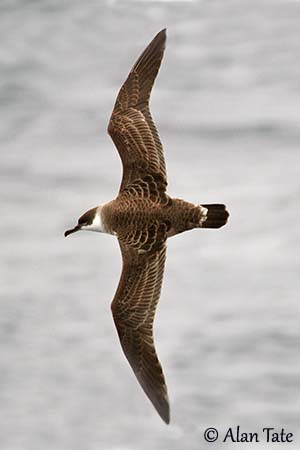
Both adults are similar, but the female is slightly smaller with shorter wings.
The juvenile resembles adults but it lacks the whitish hind collar. Body plumage and flight feathers are unmoulted in the first year and often faded and worn by September/November.
RANGE:
The Great Shearwater breeds on Nightingale, Inaccessible, Tristan da Cunha and Gough Islands, and also on Kidney Island in the Falklands.
After the breeding season, it moves NW, passing Bermuda to reach North America, and it can be seen occasionally as far North as SE Baffin and Greenland. It also moves W to Gulf of Mexico, and even inland in Ontario at Great lakes and Tennessee.
It often follows the tropical storms. It is vagrant in the Pacific Ocean to Chile and Central California.
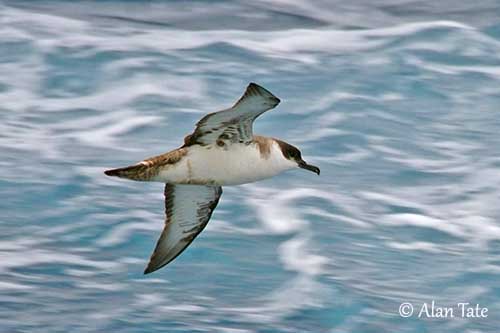
HABITAT:
The Great Shearwater spends most of its time at sea as pelagic seabird. It comes to land only for breeding on remote islands. It breeds in grassy slopes, in areas of tussock grass, ferns and Phylica arborea woodland.
CALLS AND SONGS: SOUNDS BY XENO-CANTO
The Great Shearwater gives nasal bleating and squawking calls while foraging in flocks at sea.
This species is more vocal on the ground than in flight. It can be very vocal at colonies at night. The birds give high-pitched, far-carrying howls, wailing and braying calls.
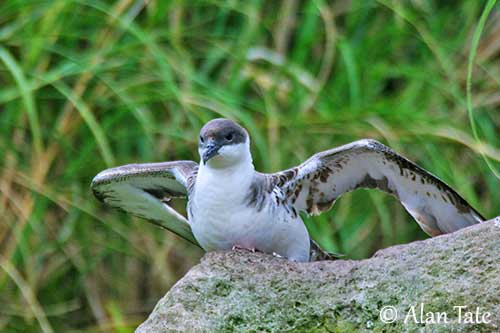
BEHAVIOUR IN THE WILD:
The Great Shearwater feeds on cephalopods, squid, fish and crustaceans caught by surface-seizing and pursuit-plunging.
It often feeds in flocks near the main breeding grounds at Tristan da Cunha. They perform pursuit-plunging from 6-10 metres above the water. The dive lasts usually 10-12 seconds at less than two metres of depth, sometimes more.
It may follow the trawlers for fish offal, and sometimes it associates with cetaceans that lead the preys to the surface.
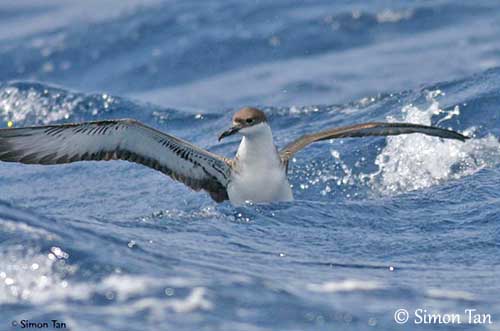

The Great Shearwater is gregarious and colonial breeder. The adults are territorial around the entrance of the burrow. Mates are monogamous with long-term pair-bonds.
The burrow is excavated with bill and feet on grassy slopes in soft soil. There is a sharp turn just inside the entrance.
The birds arrive in September at their breeding grounds, and they display and clean the burrow during several weeks. They perform the typical pre-laying exodus before returning to the colonies where they are mainly active at dusk and night. They call loudly.
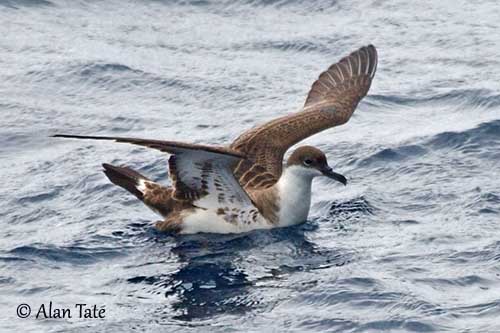
After the breeding season, the Great Shearwater migrates north to the Arctic Circle. It is a transequatorial migrant, breeding in the South Hemisphere, and wintering in the North Hemisphere.
The flight is strong and powerful. The bird glides effortless above the waves and takes advantage of the wind by using dynamic soaring. It glides on stiff wings.
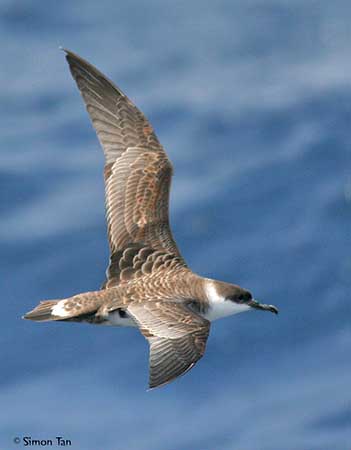
REPRODUCTION OF THIS SPECIES:
The egg-laying occurs in October/November, after the pre-laying exodus. The burrow is sparsely lined or not, and the entrance is concealed in dense tussock grass.
The female lays a single white egg. Both parents incubate during 56 days. At hatching, the chick has greyish down. It is fed regularly by the adults during the day. It fledges between 105 and 120 days after hatching. This species produces only one brood per season.
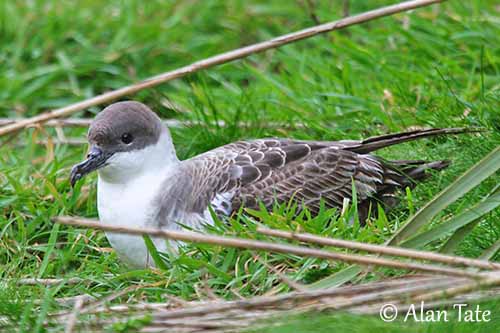
PROTECTION / THREATS / STATUS:
The Great Shearwater has fairly stable populations, in spite of great numbers of adults and chicks harvested every year by Tristan islanders.
The usual predators at the breeding sites are the feral cats. But the birds can also be taken by longlines fishery and other fishing techniques at sea.
The global population was estimated at least at 15,000,000 individuals in 2004.
The Great Shearwater is currently evaluated as Least Concern.
